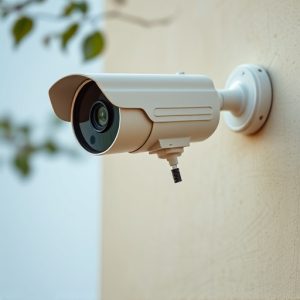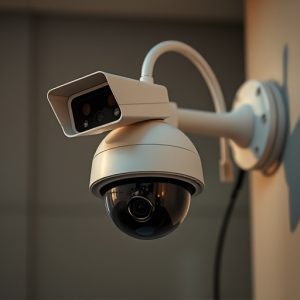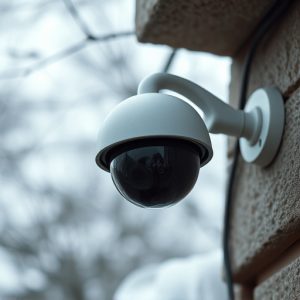Mastering Installation: Realistic Fake Surveillance Cameras for Enhanced Security
Installing multiple realistic fake security cameras is an effective, cost-efficient strategy for enh…….
Installing multiple realistic fake security cameras is an effective, cost-efficient strategy for enhancing property security and training. These deterrents signal robust security measures, reducing crime likelihood. They enable safe scenario simulation, personnel training, and protocol testing, improving overall security awareness. By strategically placing weatherproof cameras with LED indicators and moving parts in visible areas, potential intruders are psychologically deterred from targeting well-watched properties. Respecting legal boundaries while deploying these devices is crucial for maintaining privacy rights and public trust.
In today’s world, enhancing security measures has become paramount, leading many to explore innovative solutions. Realistic fake surveillance equipment offers an intriguing option, providing a subtle yet effective way to deter potential threats. This article delves into the growing demand for lifelike fake cameras, exploring their diverse applications. We’ll guide you through installing multiple units step-by-step and highlight legal considerations. Discover how these simulated devices can transform security without compromising aesthetics.
- Understanding the Need for Realistic Fake Surveillance Equipment
- Types of Fake Security Cameras and Their Applications
- Installing Multiple Fake Cameras: A Step-by-Step Guide
- Legal Considerations and Best Practices for Using Simulated Surveillance Gear
Understanding the Need for Realistic Fake Surveillance Equipment
In today’s world, where security is a paramount concern, both real and simulated surveillance equipment play crucial roles in safeguarding properties and individuals. However, the need for realistic fake surveillance equipment has emerged as a unique and strategic requirement. Installing multiple fake security cameras offers a multifaceted benefit. Firstly, it serves as a powerful deterrent to potential intruders, as it creates the illusion of enhanced security measures. This visual deception can significantly reduce the likelihood of criminal activity, giving property owners and managers a sense of peace.
Moreover, realistic fake surveillance equipment is an effective tool for training purposes. It allows organizations to simulate various scenarios without compromising actual security systems. By deploying these realistic replicas, they can prepare personnel for emergency situations, test response protocols, and enhance overall security consciousness. This strategic approach ensures that when real threats arise, the security team is well-equipped to handle them effectively.
Types of Fake Security Cameras and Their Applications
Fake security cameras, or dummy cameras, come in various types, each with unique features and applications. One popular type is the outdoor realistic fake camera, designed to resemble a genuine surveillance device, complete with LED indicators and moving parts. These are often used as a deterrent for potential intruders, providing a visual warning that your property is under watch. They can be strategically installed in visible areas like front yards, porches, or rooftops, acting as a powerful psychological barrier against crime.
Installing multiple fake security cameras can create an even more convincing and effective surveillance network. This approach allows homeowners or business owners to simulate a robust security system without the cost and complexity of actual wiring and connectivity. By dispersing these dummy cameras across different points, you can ensure comprehensive coverage, making it harder for criminals to identify and target your location. This tactic is especially beneficial in residential areas or small businesses where a visible security presence is key to prevention.
Installing Multiple Fake Cameras: A Step-by-Step Guide
Installing multiple fake security cameras can significantly enhance the appearance of a surveillance setup, deterring potential intruders while adding an air of professionalism to your security measures. Here’s a step-by-step guide to help you achieve this:
1. Plan Your Layout: Start by assessing the area you want to cover. Identify key points where realistic-looking fake cameras can be strategically placed. Consider factors like blind spots, high-traffic areas, and entry/exit points. Sketch out a rough layout to visualize the placement for optimal coverage.
2. Select High-Quality Fake Cameras: Invest in durable, weatherproof fake security cameras designed to mimic genuine ones closely. Ensure they have realistic features like lenses, infrared LEDs (for night vision), and adjustable mounts to make them virtually indistinguishable from real cameras. Choose models that offer different viewing angles to cover more ground.
3. Mount the Cameras: Attach the cameras to walls, ceilings, or other suitable surfaces using the included hardware or mounting brackets. Position them at eye level or slightly below for a more authentic look. Space the cameras evenly to create a realistic network, typically placing no more than 50-100 feet (15-30 meters) apart for clear images.
4. Connect and Test: Run cables from each camera to a central control unit or NVR (Network Video Recorder). Connect the devices to your home or business network. Power on the system and test the cameras’ feed through a monitor to ensure they capture clear, real-time video. Adjust settings as needed for optimal performance.
5. Hide Cables: Conceal cables meticulously to avoid drawing attention. Use cable ties or channels to route them behind walls or floors. Ensure all connections are secure yet discreet to maintain the realism of your setup.
Legal Considerations and Best Practices for Using Simulated Surveillance Gear
When employing realistic fake surveillance equipment, it’s crucial to understand and adhere to legal boundaries to avoid potential pitfalls. The use of simulated cameras and other security gear is generally permissible for private property owners, but public spaces may have stricter regulations. In many jurisdictions, installing multiple fake security cameras requires explicit consent or permits, especially in highly-trafficked areas or near sensitive locations like government facilities.
Best practices suggest transparency and responsible deployment. Clearly label the simulated equipment as non-functional to prevent confusion or alarm. Positioning them strategically can enhance security perception without recording actual footage. Regularly update and maintain these devices to ensure they remain realistic and effective. Additionally, staying informed about local laws and industry standards is essential to protect privacy rights and maintain public trust.
Realistic fake surveillance equipment has evolved into a valuable tool for both security professionals and everyday folks. By understanding the types available, their applications, and legal considerations, individuals can effectively deploy simulated gear to enhance safety and deter crime. Mastering the art of installing multiple fake cameras, as outlined in this guide, allows for comprehensive coverage and a layered defense, making it an essential skill in modern security management.


